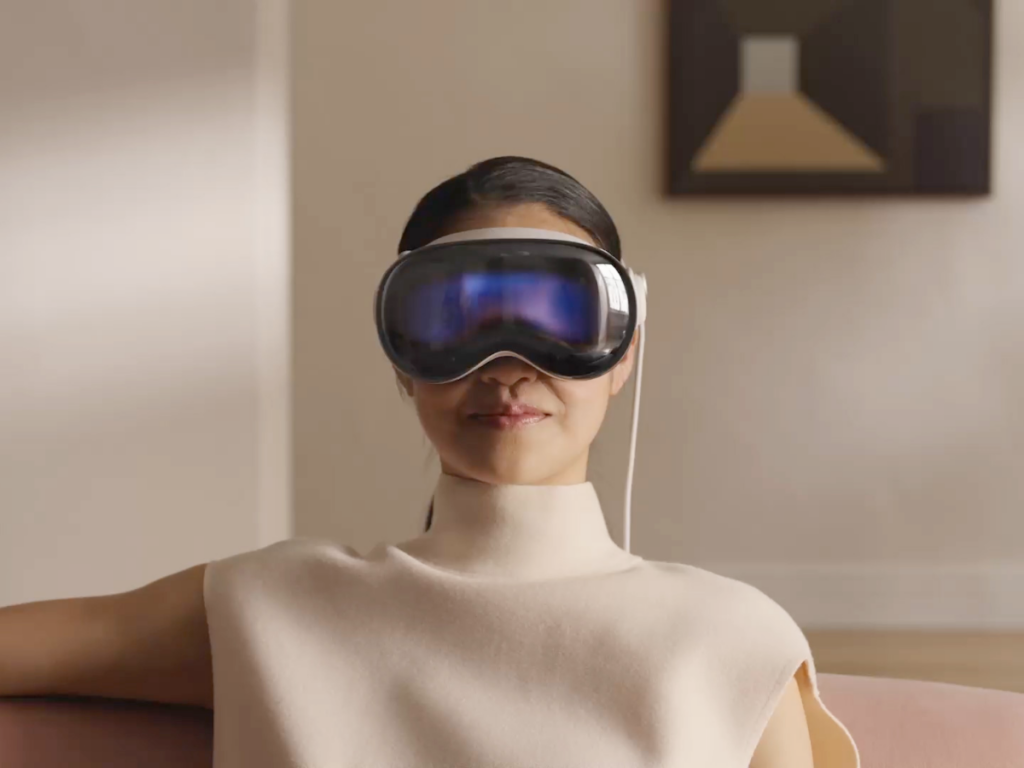
How Is the Apple Vision Pro Rewiring Our Brains?
This month, Apple released its much-anticipated Vision Pro. For $3,500, you can strap on one of these VR headsets and experience a type of augmented reality (although experts disagree about the correct terms to use for this “spatial computing” or “passthrough” concept).
According to Business Insider, the Vision Pro works using “cameras and other sensors that capture imagery of the outside world and reproduce it inside the device. They feed you a synthetic environment made to look like the real one, with Apple apps and other non-real elements floating in front of it.”
But that’s causing some pretty serious problems for early adopters.
A team at Stanford took Apple’s suggestion to wear the headsets for hours at a time. The short-term side effects weren’t surprising. Depth-perception became practically non-existent as folks misjudged distances both close up and far away. Objects in the headsets appeared warped, changing in size, shape and even color, especially when they moved their heads around. (Go figure, a full video render doesn’t work as fast as our eyes and brains do.)
But the Stanford team was determined to soldier on. And as its members continued to wear their headsets for days at a time, the problems got much, much worse.
They experienced what’s called “simulator sickness,” which causes nausea, headaches and dizziness—and this was in spite of the team’s experience with using VR headsets before. They also noticed that their brains and muscles eventually adapted to the distorted worldview, allowing them to function more normally. However, upon removing the headsets, their bodies had to readjust again. And the longer they used the headsets, the longer that normalizing process took.
Even with those problems, the Stanford team stayed relatively safe since they had “minders” keeping an eye on them to make sure they didn’t walk into walls or trip. But what if this now commercially available tech is used while driving? Or what if someone uses it all day at work and then attempts to bike home? It could cause some pretty serious accidents and injuries since our brains simply aren’t designed to work that way.
And then there’s the philosophical implications. It’s still too early to know how humans will adapt to this new immersive technology—how it might impact social interactions and technological reliance—but it certainly warrants caution. After all, a decade ago, we had no idea how social media would impact us in the long run, and we’re now reeling from its effects.

The United States Is Cracking Down on Social Media
Last year a bipartisan group of 42 attorneys general sued Meta because it “designed its Facebook and Instagram products to keep young users on them for longer and repeatedly coming back.” In other words, because of its addictive features.
On January 31, the heads of Meta, TikTok, Snapchat, X (formerly Twitter) and Discord testified at a Senate Judiciary Committee hearing investigating whether social media platforms should bear more legal liability when children are harmed online.
It was certainly an emotionally charged session with the families of many of those harmed children present. “You have blood on your hands,” Sen. Lindsey Graham told the executives, several of whom apologized to those families.
Unfortunately, that’s about all that happened. Despite a bipartisan consensus that the United States’ current laws aren’t adequate to protect children online, lawmakers have run into roadblocks creating legislation that won’t violate our First Amendment rights. So some states are taking individual action. Florida passed a bill banning social media for kids under 16. A new law from Utah requires parental consent to create an account. Social media companies must consider the health and well-being of children before implementing new features for California users. And a proposal out of New York would force social media companies to disable their algorithms on child-owned accounts.
But for parents, relying on the judicial system to protect your children may be too little too late. Parental controls are often helpful for younger children, but for teens, they’re “ineffective,” says Stephen Balkam, founder of the nonprofit Family Online Safety Institute. So here are some tips to help keep your teens safe as they navigate the world of social media:
- Go over safety settings with your teens on their apps. Doing so can help them anticipate the dangers they might face. Balkam also adds that “when parents and teens work together to devise a set of tech rules—and the consequences for breaking them—teens are more likely to abide by them.”
- No devices in the bedroom, especially at night. Multiple studies have demonstrated how screens can disrupt healthy sleep patterns—and more than 70% of teenagers don’t get enough sleep as it is.
- Demonstrate good tech habits yourself. A report from 2016 found that parents spend an average of nine hours a day with their own screens. And adults are just as susceptible to social media addiction and poor sleep due to screen overuse as teens are.

#HashtagTrending
Hashtags, trends, reels, sounds, tracks, stories—we know it feels impossible to keep up with what the kids are into these days. But here’s a quick overview of what your teen might be posting/watching on TikTok, Instagram and all the other “socials.” And in honor of Valentine’s Day (since we’re still in the month of February), we’ll focus on some dating trends:
- “Situationship” – This term is commonly used when two people can’t come to a consensus on what sort of relationship they have. And, of course, that can be frustrating not only for confused teenagers, but for parents trying to help them navigate these sorts of situations.
- “Breadcrumbing” – This is the act of giving someone just enough attention to keep them romantically hopeful. Typically, the person leaving breadcrumbs has no intention of dating that person, but they want to keep them around as an option, “just in case.”
- “Orbiting” – Essentially, an orbiter is a digital stalker. They no longer have a romantic interest in the person they follow online, but it can certainly cause distress as the orbitee tries to understand why this person won’t leave.
- “Ghosting” – This one is important as it can occur in both romantic and platonic relationships. But basically, you “ghost” someone by cutting off all contact with them without explanation. And that can be particularly upsetting for vulnerable teenagers.
- “Phubbing” – Has your teenager ever ignored your presence in favor of their phone? Congratulations, you’ve been phubbed. It’s a combination of “phone” and “snubbing,” and often it’s not done to be intentionally rude but rather to stay connected with others through social media or texts. So advise your teen that it can be perceived as rude, even hurtful, to those who are physically present at that moment.
- “Soft-launching” – Parents probably won’t be a fan of this one, but it’s become popular to “soft-launch” relationships. Mostly it involves hinting there’s someone special in your life by posting a picture of your joined hands, or their silhouette, or even the person holding a coffee mug so that it hides their face and keeps their identity ambiguous.
- “Simp” – Again, parents probably won’t be fans of this trend. “Derived from the term ‘simpleton,’ this popular term began as a way to mock men who pander to women in an effort to sleep with them,” according to USA Today. It typically applied to guys who would donate money to YouTubers and other virtual influencers. But recently, the term has adapted to describe anyone who shows affection for someone else. And it’s taken on new life in the form of “simp-shaming,” mocking any man who genuinely cares for the well-being of women, implying that this is somehow “unmanly.”
- “The Ick” – This is the feeling of becoming suddenly repulsed by someone you once found attractive. And while these feelings can sometimes be legitimate, parent should be aware if their teen gets “the ick” too frequently as it might be a warning of deeper attachment issues.
- “Paperclipping” – Similar to “breadcrumbing,” paperclipping is when an ex reaches out intermittently, not because they’re interested but because they want you on the back burner as an option. It’s a narcissistic behavior that should be discouraged if you notice your teen exhibiting it. And if your teen is being paperclipped, try reaffirming their value so they can end the toxic relationship themselves.








2 Responses
Good article.
Social media like TikTok is certainly addictive. I do not use TikTok, but have seen people watch it for hours at a time. On the other hand, scrolling through the web can be just as addictive, and in my own life, has the same adverse effects as watching TikTok or scrolling through Facebook. Concentrating on movies is difficult, and sometimes, so is reading a book. Adults have to be very careful on what they do online too, as children can and will pick up on those behaviors. Having your life revolve on social media may be fun, but it is not Biblical. You will be surprised that social media can be an idol, and it can take away from your time with God. Be careful going into it.